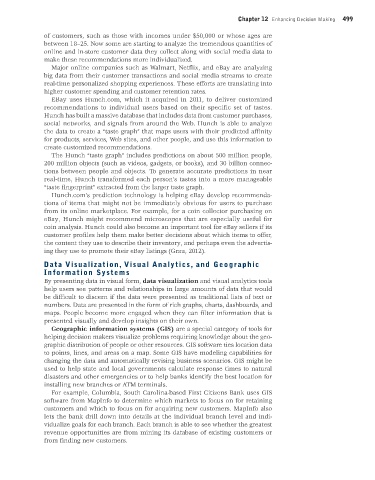Page 500 -
P. 500
Chapter 12 Enhancing Decision Making 499
of customers, such as those with incomes under $50,000 or whose ages are
between 18–25. Now some are starting to analyze the tremendous quantities of
online and in-store customer data they collect along with social media data to
make these recommendations more individualized.
Major online companies such as Walmart, Netflix, and eBay are analyzing
big data from their customer transactions and social media streams to create
real-time personalized shopping experiences. These efforts are translating into
higher customer spending and customer retention rates.
EBay uses Hunch.com, which it acquired in 2011, to deliver customized
recommendations to individual users based on their specific set of tastes.
Hunch has built a massive database that includes data from customer purchases,
social networks, and signals from around the Web. Hunch is able to analyze
the data to create a “taste graph” that maps users with their predicted affinity
for products, services, Web sites, and other people, and use this information to
create customized recommendations.
The Hunch “taste graph” includes predictions on about 500 million people,
200 million objects (such as videos, gadgets, or books), and 30 billion connec-
tions between people and objects. To generate accurate predictions in near
real-time, Hunch transformed each person’s tastes into a more manageable
“taste fingerprint” extracted from the larger taste graph.
Hunch.com’s prediction technology is helping eBay develop recommenda-
tions of items that might not be immediately obvious for users to purchase
from its online marketplace. For example, for a coin collector purchasing on
eBay, Hunch might recommend microscopes that are especially useful for
coin analysis. Hunch could also become an important tool for eBay sellers if its
customer profiles help them make better decisions about which items to offer,
the content they use to describe their inventory, and perhaps even the advertis-
ing they use to promote their eBay listings (Grau, 2012).
Data Visualization, Visual Analytics, and Geographic
Information Systems
By presenting data in visual form, data visualization and visual analytics tools
help users see patterns and relationships in large amounts of data that would
be difficult to discern if the data were presented as traditional lists of text or
numbers. Data are presented in the form of rich graphs, charts, dashboards, and
maps. People become more engaged when they can filter information that is
presented visually and develop insights on their own.
Geographic information systems (GIS) are a special category of tools for
helping decision makers visualize problems requiring knowledge about the geo-
graphic distribution of people or other resources. GIS software ties location data
to points, lines, and areas on a map. Some GIS have modeling capabilities for
changing the data and automatically revising business scenarios. GIS might be
used to help state and local governments calculate response times to natural
disasters and other emergencies or to help banks identify the best location for
installing new branches or ATM terminals.
For example, Columbia, South Carolina-based First Citizens Bank uses GIS
software from MapInfo to determine which markets to focus on for retaining
customers and which to focus on for acquiring new customers. MapInfo also
lets the bank drill down into details at the individual branch level and indi-
vidualize goals for each branch. Each branch is able to see whether the greatest
revenue opportunities are from mining its database of existing customers or
from finding new customers.
MIS_13_Ch_12 global.indd 499 1/17/2013 2:30:32 PM

